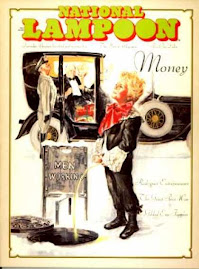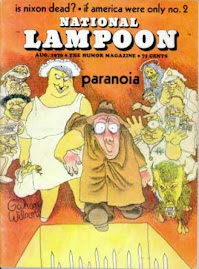The Twisted World of John Stossel Propaganda

Forced to apologize for lying:
On February 8th, 2000 20/20 broadcast a story by John Stossel claiming that foods sold at organic and health food stores were no more safe to eat than food bought at conventional supermarkets. Stossel claimed that tests commissioned by ABC TV showed that food purchased at organic markets had higher rates of E. Coli contamination and equivalent amounts of pesticides.
Investigation by the Environmental Working Group revealed that the experts cited by ABC's 20/20 for the story had never actually performed the tests ABC claimed in the story.
Despite the embarrassment, Stossel repeated the story on July 7, 2000, informing the EWG through an intermediary that he would not even respond to the allegations. ABC TV, however, embarrassed by the publicity, ordered Stossel to apologize.
Stossel has also been accused is mireporting in his story on Erin Brockovich, the California woman who found Chromium 6 in her town's drinking water.
Stossel presented skewed 20/20 segment on "stupid" public schools
"On the January 13(2006) broadcast of ABC's 20/20, host John Stossel presented an hour-long "special report" on the purported failures of public schools in the United States. Titled "Stupid in America: How We Cheat Our Kids," the report tilted heavily in favor of those who advocate for expanding such "school choice" initiatives as voucher and charter school programs, ostensibly as the means for increasing academic achievement.Through a series of misleading claims, a lack of balance in reporting and interviews, and video clips apparently created primarily for entertainment, Stossel's report failed to offer viewers an accurate picture of the debate over charter schools and voucher programs, and gave significantly greater coverage to the arguments of "school choice" proponents, with Stossel frequently criticizing public schools. At one point, the reporter warned, "Most Americans don't know what stupid schools are doing to American kids."
John Stossel Should Do a Fraud Investigation on Himself
Economist's View "John Stossel makes a false claim about tax cuts. As we know, tax cuts do not pay for themselves. No credible analyst claims that. But John Stossel does:The Tax-Cut Myth, by John Stossel, RCP: ...[T]ax cuts stimulated the economy and increased tax revenues. It happens because, as the Laffer Curve illustrates, lower rates mean higher rewards for productive activities. ...
Any decent reporter would know that isn't true. He can't even keep his story straight. After saying it was tax cuts that increased revenues, he then says:
President Bush brags that the deficit is coming down -- and it is. ... But that's largely because your FICA taxes currently exceed Social Security and Medicare payments. ...
He then goes back to the tax cuts increase revenues propaganda and quotes the president pushing the same myth:
Bush boasted last year, "This economy is growing, federal taxes are rising, and we're cutting the federal deficit... Some in Washington say we had to choose between cutting taxes and cutting the deficit. Today's numbers show that that was a false choice. The economic growth fueled by tax relief has helped send our tax revenues soaring."
Remember what Andrew Samwick, who was chief economist of the Council of Economic Advisers from 2003 to 2004, said about statements like this?
Next, Stossel gets himself all tied up in knots. Tax cuts are good. But if tax cuts increase government revenue, then tax cuts are bad because it means government takes more of our money. So tax cuts aren't good after all:
But I don't want tax revenues to soar. That's money you and I could be spending for things we want. I want revenue and spending and government overall to shrink. So I'm not celebrating with the president.
So a higher tax rate is bad, a lower tax rate is bad, and the tax rate we have is unacceptable. It's all the government's fault anyway. Because of politicians, we'll never, ever get to the promised land on the other side of the Laffer curve:
If revenues are pouring in, why don't the politicians return it to the taxpayers instead of spending it? Because politicians love to spend money. They get reelected not by how much they save but by how much they shower on interest groups.
He has a book called Myths, Lies, and Downright Stupidity. I haven't read it and don't plan to, but from the above, I assume it's autobiographical."



























8 comments:
Actually the Laffer Curve is legit.
Please see the tax revenues for this year, and last year, and the year before. Go ahead. Look em up.
There comes a point where there would be decreasing revenues from decreasing taxes. We are not there yet. Right now, we're seeing increased revenue after taxes have been decreased -- we're setting records right now for the amount of money the government is taking in (and considering the soon to be 3billion a year Federal budget, we better).
The Laffer Curve
By Robert Sturgeon
Some of you may share the mistaken belief that the Laffer Curve, named for Dr. Arthur Laffer, was tested and found wanting during the Reagan Administration. Nothing could be farther from the truth.
There are two possible causes for your error. The first is that you may simply not know what the Laffer Curve is. This, combined with a natural tendency to agree with the "conventional wisdom," may lead you to just mindlessly nod your head in agreement every time you hear some T.V. network reporter blithely dismiss the "discredited Laffer Curve."
The second possible cause for your error may be that you do not understand what results the Laffer Curve promises. This is really a part of the greater problem mentioned above, so let us begin there.
For us to gain a rudimentary understanding of the ideas incorporated into the Laffer Curve, we must understand a tiny bit about economics. Economics is really just basic human psychology as applied to money and business affairs. We assume that people will react to the realities of the world of money and business more or less like they react to any other set of stimuli. They tend to act in their own and their family and friends' best interests, as they see them. The Laffer Curve results from our assumptions about how people will react to varying rates of income taxation.
Now we must put our understanding of human nature to work. We must ask ourselves two questions, the answer to the first being obvious, and the answer to the second being not so obvious, but just as certain. The first question is, "If the income tax rate is zero %, how much income tax revenue will be raised?" The answer is, of course, "None."
Now, here is where it gets a bit tougher. The second question is, "If the income tax rate is 100%, how much income tax revenue will be raised?" To answer this question, we must place ourselves in the position of an income earner who faces a tax rate of 100% on every extra dollar he earns. Will he have any reason whatsoever to earn any more money? The answer is, "No, he won't." He will refrain from any activities likely to result in taxable income. So the income tax revenue from a 100% income tax will be zero, or nearly zero. There will always be a few suckers who go ahead and earn some money, only to have it taxed away. But the number of people willing to do so must be exceedingly small. For all practical purposes, the number is zero.
Okay, now we get to the nub of the "infamous" Laffer Curve. We must take the ideas discussed above and reach some conclusions. The reasoning goes like this: If a zero % income tax rate brings in zero revenue, and if a 100% income tax rate brings in zero revenue, the tax rate which will bring in the most revenue must be somewhere between zero % and 100%. It necessarily follows that in a given economy, there is some optimal income tax rate which will bring in the most revenue possible. In that economy, a lower than optimal rate will bring less revenue, and a higher than optimal rate also will bring in less revenue. Are we all still together here? Did you get that? If not, go back and do it again. Keep doing it until you get it.
Okay, that is all the Laffer Curve claims. Let's all say this together, "In any given economy, it is possible that the income tax rates are already too high, and if the authorities wish to bring in more income tax revenue, they must lower the tax rates." Do we all understand that? Even the Democrats amongst us?
The Laffer Curve does not claim that lowering income tax rates will always bring in more revenue. It only claims that a lower income tax rate may bring in more revenue. If the tax rates are already very low, lowering the rates may not bring in more revenue. But if the rates are too high, lowering the rates will bring in more revenue.
The problem people tend to have regarding the Laffer Curve is that they confuse economics with their political considerations. Many people have political reasons to desire high income tax rates on the earnings of the rich. They wish to prevent the rich from earning more money, even if the resulting tax revenue is smaller than it would otherwise be, and the economy less productive than it would otherwise be. These people do not believe that the income tax on the rich can ever be "too high." They are willing to deprive the government of revenue and deprive the economy of the productivity of the rich, all for the sake of their politics. There really is no arguing this point, as it is merely the outward manifestation of envy.
The Laffer Curve does not address questions of envy and redistributionist politics. It only addresses the question of how to have the healthiest economy producing the highest income tax revenue.
The Laffer Curve does not claim to know exactly what tax rate is the "right" tax rate. In fact, the only way to know if the current tax rates are too high is to lower them, and see whether revenues increase or not. If the revenues increase, the rates were too high. If the revenues decrease, the rates were too low. Of course, it would be equally valid to run the experiment the other way around: raise the tax rates and observe the results. The choice is the politicians' to make, based upon whether the current rates "seem" to be high or low. In 1981, the rates seemed rather high. The Laffer Curve experiment showed that the rates were, indeed, too high.
Now, let us consider whether the Laffer Curve "failed" to deliver on its promises during the Reagan administration. Remember, the Laffer Curve does not promise to balance the budget. The Laffer Curve does not promise to solve social problems. The Laffer Curve does not promise to force elected representatives to propose and enact lower spending programs. The Laffer Curve only promises that, if the tax rates are too high and they get lowered, revenues will increase. Income taxes were lowered (and "flattened") during the Reagan administration. Income tax revenues increased. In fact, they increased a great deal. Unfortunately, neither the Republican Reagan administration nor the Democrat-controlled Congress were interested in lowering the rate of growth in federal spending. While the income tax revenues increased substantially, federal spending increased even more. The result was that the federal government ran up a staggering national debt. But please, let's not blame it on the Laffer Curve!
http://www.vistech.net/users/rsturge/laffercu.html
---
Estimates of the effectiveness of the Laffer curve
In 2005, the Congressional Budget Office released a paper called "Analyzing the Economic and Budgetary Effects of a 10 Percent Cut in Income Tax Rates" [2] that casts doubt on the idea that tax cuts ultimately improve the government's fiscal situation. Unlike earlier research, the CBO paper estimates the budgetary impact of possible macroeconomic effects of tax policies, i.e., it attempts to account for how reductions in individual income tax rates might affect the overall future growth of the economy, and therefore influence future government tax revenues; and ultimately, impact deficits or surpluses. The paper's author forecasts the effects using various assumptions (e.g., people's foresight, the mobility of capital, and the ways in which the federal government might make up for a lower percentage revenue). Even in the paper's most generous estimated growth scenario, only 28% of the projected lower tax revenue would be recouped over a 10-year period after a 10% across-the-board reduction in all individual income tax rates. The paper points out that these projected shortfalls in revenue would have to be made up by federal borrowing: the paper estimates that the federal government would pay an extra $200 billion in interest over the decade covered by his analysis. To support these calculations, the paper assumes that the 10% reduction in individual tax rates would only result in a 1% increase in gross national product, a figure some economists consider too low for current marginal tax rates in the United States. [3][4] The paper appears to focus on Federal government revenue only and does not look at the total public sector revenue (i.e., it does not include increases in local and state government revenue).
http://en.wikipedia.org/wiki/Laffer_curve
Want some fun? Go to YouTube, do a search on Stossel or David Schultz, and watch the pro wrestler slap the living crap out of Stossel when he asks if wrestling is fake. Of course JS got a settlement, but it was funnier than heck and unlike pro wrestling the slaps weren't pulled.
Something funnier.
A friend of my had a video of 20/20 from about 25 years ago. John Stossel
is chastising the food photography industry for the tricks food stylists do to make food packaging look 100 times better than what you see when you put the actual product on the plate. He even criticizes a packaged food company for displaying 2in chunks of meat on the package and including pea sized
morels in the actual product. I wonder how John S. would react to seeing that video?
Did he suddenly see the light?
Did Hugh Downs ( Who I've always admired until I discovered he'd become a libertarian ) lure John into the Libertarian fold?
At present John Stossel has a huge Libertarian axe to grind. I'm sure his propaganda has influenced millions.
Just watching Stossel get slapped around makes me day better.
www.youtube.com/watch?v=C35wyVQxXUA
I wonder what Mr. Stossel had to say after that. As a fan of Friday Night Smackdown (my wife's favorite TV show), obviously professional wrestling isn't faked as far as bumps, bruises and the potential for career and/or life threatening injuries. Let's say the outcome of matches maybe heavily predetermined.
My daily reading of the sports pages rarely turns up anything remotely related to professional wrestling -- unless somebody dies.
With that said, Stossel should have check with the late Andy Kaufmann before learning the joys of the open head slap.
I bet that left a mark...
He claimed it ruptured his eardrum. I wish Dr. D would have kicked him in the nuts too.
ROTFL! That is the very definition of a "bitch slap"!
Post a Comment